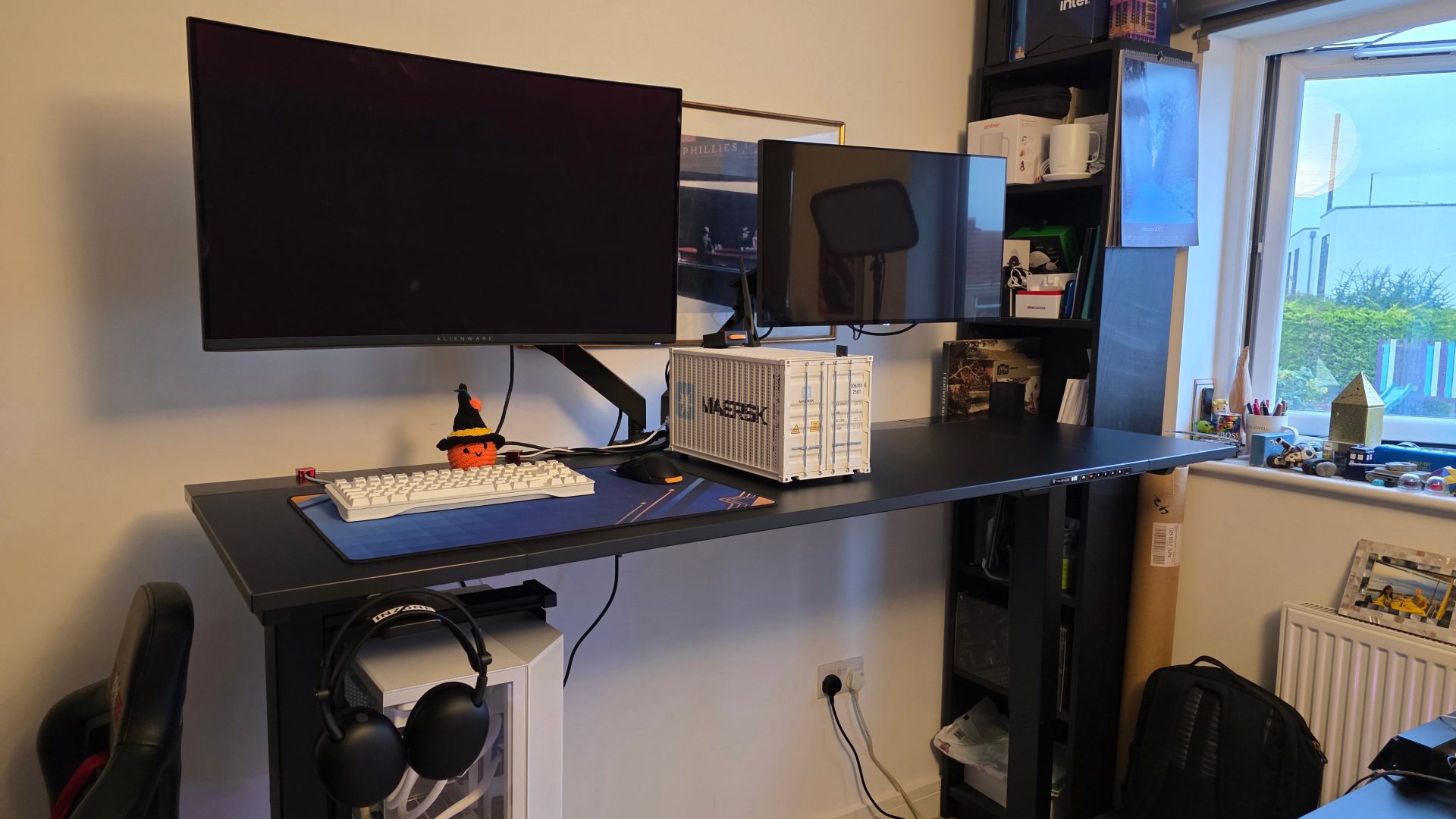Secretlab Magnus Evo Desk Review – A Premium Desk Kitted for Gaming


The Secretlab Magnus Evo is a stylish, smartly-built gaming desk that sets itself apart with genuinely useful PC-focused features, good build quality, and an intuitive assembly process. The overall level of quality here is high, which is understandable given the $750 starting price and Secretlab’s reputation of producing high-end gaming chairs and the two prior Magnus desks. The key this time is a streamlined design, bringing the motorized sit/stand functionality and integrated power from the Magnus Pro to a slightly lower price point – along with a simpler and more capacious cable tray and static magnetic zones along the rear edge and front corners of the desk.
Secretlab Magnus Evo – Design and Features
Like the Magnus Pro that precedes it, the Magnus Evo is made from a combination of MDF and steel, with a stable inverted-T base, thick legs with integrated electric motors, and a wide (59-inch or 70-inch) desktop that’s 25 inches deep and 0.8 inches thick. Unlike the Magnus Pro, which featured a flip-up edge with an integrated cable gully, the rear edge of the desk is fixed and made from steel, allowing you to conveniently whack down magnetic accessories or securely install friction-fit mounts. The desk’s height ranges from 28 to 46 inches, can handle a maximum weight of 265 pounds, and can raise or lower around six inches in five seconds. It’s a similar spec sheet to the Ikea Idåsen, Herman Miller Nevi, Flexispot EQ4, and Corsair Platform:6 sit/stand desks I’ve tested for Eurogamer, and I’m willing to bet the Magnus Evo’s core components will prove equally reliable given the mature state of electric motors in 2025.
However, the Evo’s controls are a step ahead of anything else I’ve tested, as they look integrated into the desktop rather than being affixed to the underside. As with most other contemporary electric sit/stand desks, you get a height read-out (to the nearest tenth of a centimeter) and the ability to save and recall three preset heights (presumably one each for sitting, standing and cleaning). The touch controls are easy to accidentally brush with a finger, but thankfully there is a quick on/off switch here to disable them when not in use. Moving the desk up and down is smooth and relatively quiet, and the desk only starts to feel a touch unsteady when it’s approaching its highest setting. The motors also automatically reverse course if they begin to meet resistance, so I didn’t worry about the desk causing any damage to limbs, pets, or nearby objects.
Where the Magnus Evo differs more substantially with (most) of those aforementioned desks is the focus on gaming features. There’s no RGB here, thankfully, with Secretlab instead opting for an integrated power plug and a capacious metal basket to keep all of your cables hidden. The whole power delivery system is smartly designed, with the desk’s power coming from a cable integrated into the left or right foot, running up to the motors and also to a full-size outlet on the same side. (You can choose which side during assembly, with the default left-side installation giving you a plug on the rear of the desk, while the right-side installation has a plug on the front.) My UK unit came with a pleasantly hefty plug, normally only found with 1200W+ PC power supplies, and can handle 2500W at 12A – though the spec sheet reveals a more modest 1440W at 12A in the US and Japan, or 2000W at 10A in Australia and New Zealand. From here, the angled port has a straight shot to the cable tray, which is large to conceal a hefty 12-port UK power strip and can be pulled down to a 30-degree angle for setup, then pushed back up to its magnetic attachment point.
I found the cable tray much easier to use than that of the Corsair Platform:6, which tends to annoyingly grab cables due to its high back, though I think it might struggle to accommodate a full set of 12 power cables and whatever other peripheral or speaker cables that might one day live there. The Corsair Platform:6 also required the installation of a horizontal bar above the desk surface for its monitor mount, limiting compatibility with third-party mounts substantially, so I’m happy to see Secretlab embracing a more traditional mounting solution here.
Looking for a gaming chair upgrade, too?
Check out our roundup of the best gaming chairs!
Secretlab Magnus Evo – Assembly
As the surface of the Magnus Evo consists of three sections, the single box that arrived was significantly smaller than I expected for a 70-inch desk – though it was still heavy enough at 143 pounds that I opted to open it up downstairs, then carry each piece up individually. Each element thoughtfully carries an alphabetic identifier, which is easy to cross-reference with the list of materials and the assembly instructions. This extends down to the individual bolts and tools provided, so finding the next element to install was consistently straightforward.
The manuals provided with the desk and its accessories were easy to parse, with generously sized and detailed illustrations, clear language, and logically arranged steps. These manuals did contain a few minor errors (such as asking me to remove washers that didn’t exist or remove a cardboard cover that was plastic), along with some grammatical oddities (like “sideway” and an incorrectly deployed “it’s”), but the only true moment of confusion I had was when installing the monitor mount. This must predate the Magnus Evo, as it refers to opening the magnetic cover to install the base, which doesn’t jibe with the static metal used here (but does make sense on the earlier Magnus Pro).
Secretlab promises a 15-minute build time for the Magnus Evo, but it took me closer to an hour to get everything ready, even with a second person on standby to help out when needed. Conceptually, it’s straightforward at least:
- Marry the desk surface with an extension on the left and right
- Connect the legs with their integrated motors (with the power supply on the left or right as you prefer)
- Add on the cable tray
- Install the feet
- Flip the desk upright
- Plug it into a power source
- Perform a quick sit/stand self-calibration
From here, you’re free to install any further accessories, ranging in difficulty from easy (the headphone holder, which comes pre-assembled and magnetically attaches to the left or right front corners of the desk) to somewhat tricky (the PC case/tower mount, which requires unscrewing and rescrewing four bolts, then clipping in increasingly weighty metal arms and the PC itself). The latter is the only accessory I’m still not sure I’ll keep using – while the PC I’m using is well under the maximum width and 55-pound weight limit, I’m not a huge fan of the way the PC wobbles slightly when poked and is only supported across perhaps 60 percent of its width.
The most successful accessory in my eyes is the monitor arm, which is available in a single or dual configuration. I opted for the double, which refreshingly is secured to the metal-topped surface from the top using a hand tool – so there’s no need to crawl under the desk like every other monitor mount I’ve ever owned. From here, I dropped on the lower then upper arms, screwed a VESA plate to the back of the monitor (with stand-offs available, if needed), and then dropped the augmented monitor onto the arm. This worked well, at least until the extremely pointy monitor arms were pushed backwards into my wall with some force. Perhaps consider asking a second person for help to hold the end of the arm in place if you’re working with a monitor that’s heavy enough to need two hands to lift.
The only truly negative experience I had assembling the Magnus Evo was being left with a huge amount of nonrecyclable foam afterwards, which was enough to completely fill the black rubbish bin that’s only collected every fortnight in my area. I’m sure that this foam is cost-effective for protecting the desk’s components, but I’d love to see Secretlab follow the lead of other PC peripheral manufacturers like Razer and Logitech in using more easily recyclable materials like paper or cardboard wherever possible.
Secretlab Magnus Evo – Gaming
The Magnus Evo performed well in testing for both work and gaming, whether standing or sitting. In fact, it’s quickly become my favourite desk to use out of the three in my office, thanks to its cleaner design, easier-to-access cable management tray, and convenient magnetic accessories. It feels stable enough at all heights, particularly when sitting down, and moves up and down with minimal fanfare.
The Evo XL model I’m using is comfortably large enough for a 32-inch main monitor, a 27-inch secondary monitor, a small form factor gaming PC, and a full-size gaming PC, plus all of the attendant cables and accessories this setup requires. The MDF surface is comfortable and easy to wipe clean, while the rear metal portion feels durable enough to handle an effectively unlimited number of mountable accessories – which is good, as I’ll soon need to add lights, a camera, and a microphone for video production. The integrated power port makes the bottom of the desk look so much cleaner than its predecessors, and I feel a renewed vigor for trying to keep my cable management on point. Of course, there is an optional cable management accessory pack as well, with intensely strong magnets, so there’s no excuse not to make things look clean.
The only minor worry I have with the whole setup is the stability of the PC case/tower mount. Having your PC move up and down with the desk looks great and makes it easy to run cables out-of-sight along the leg column, but I do worry when the PC wobbles a bit when I nudge it with my knee. Even while running 18 pounds below the maximum weight requirement, I think I’d feel more secure if my chosen case was a little narrower. I’d pop in the container PC instead, but this small form factor design is too short for the mount and therefore has to sit above.





